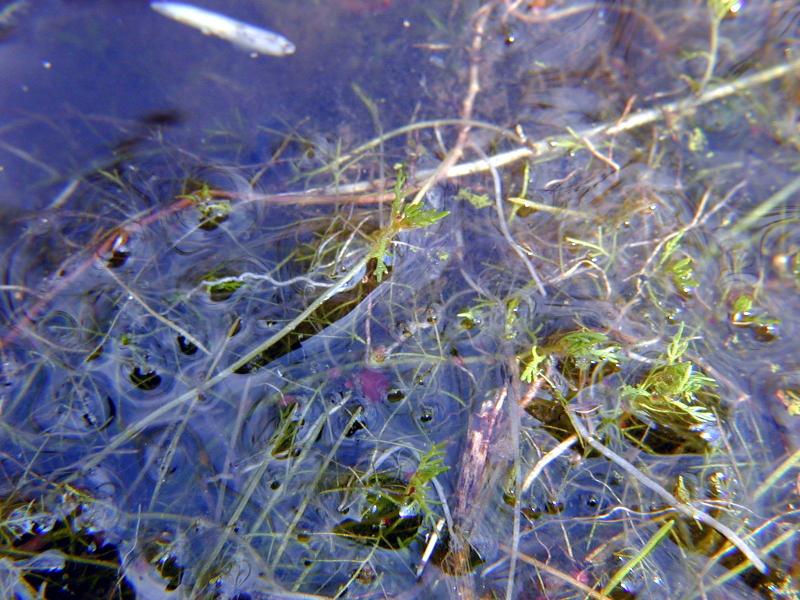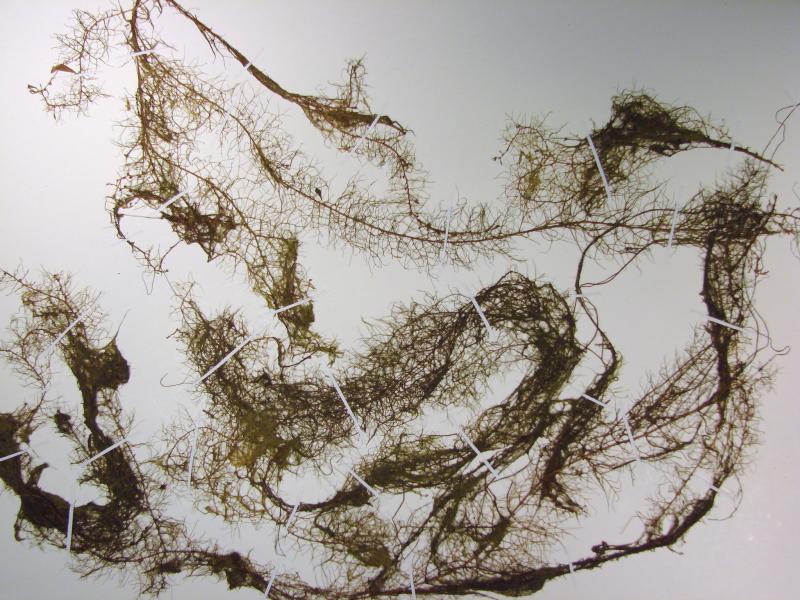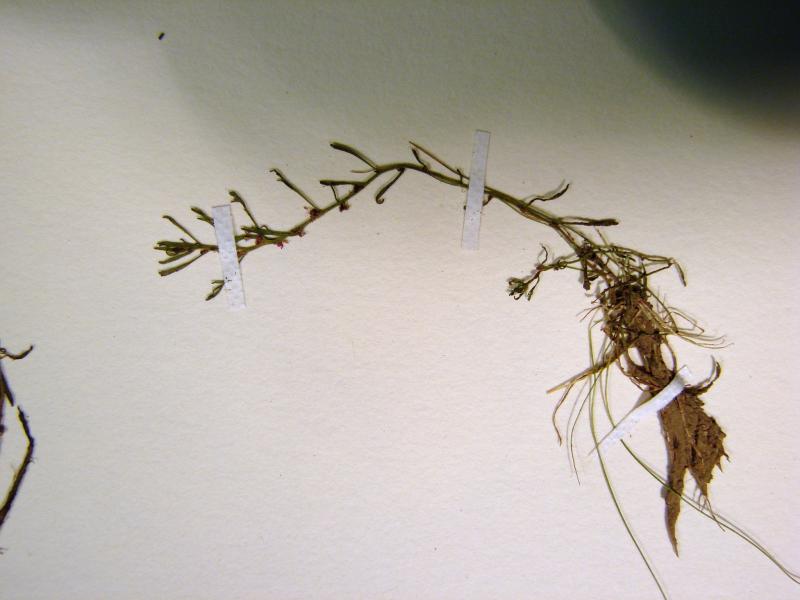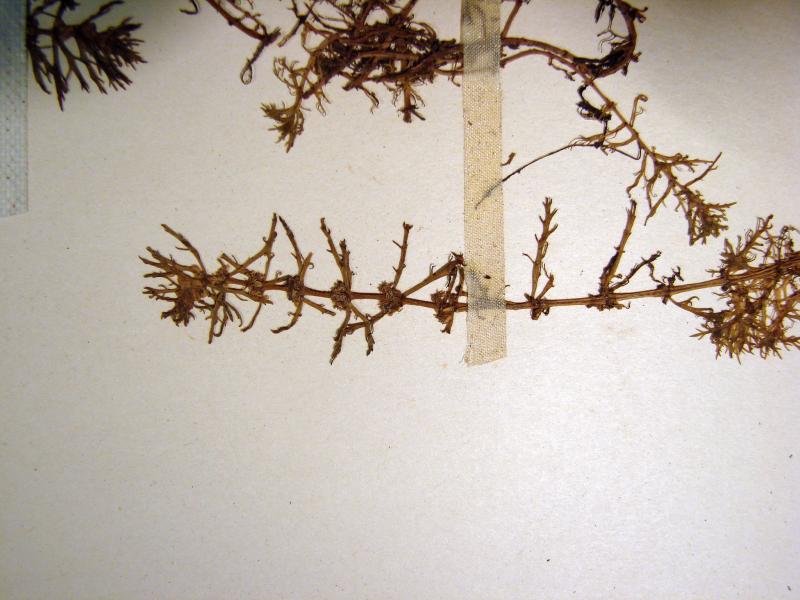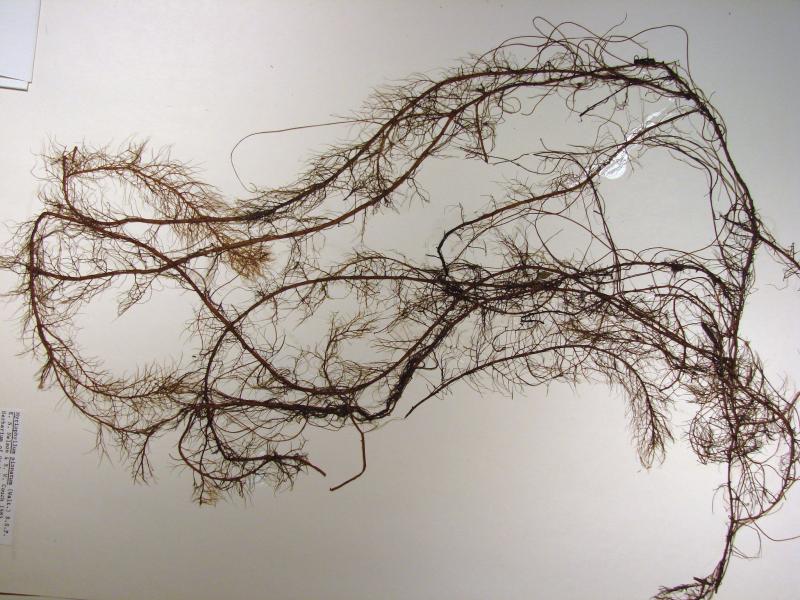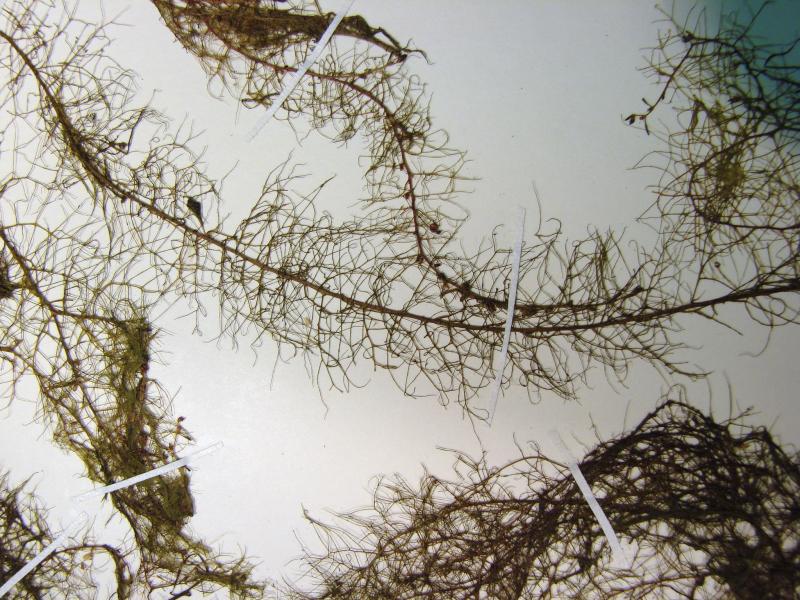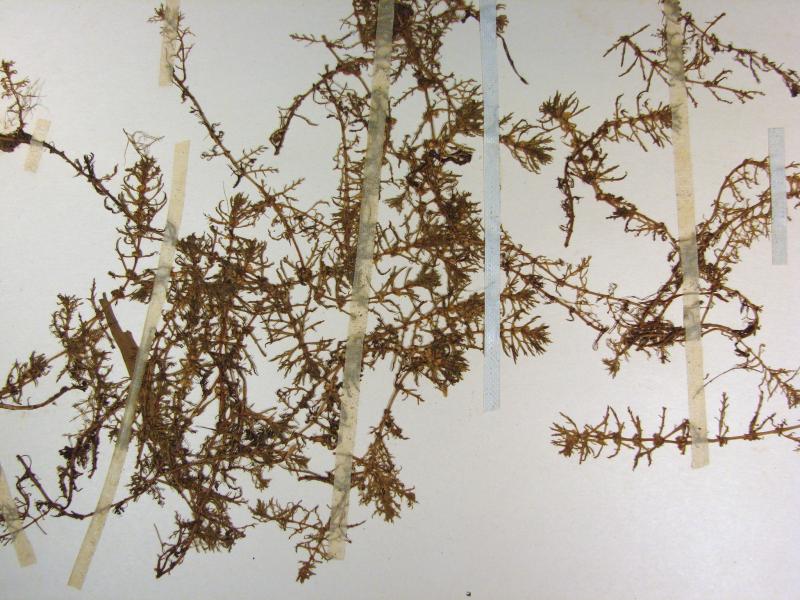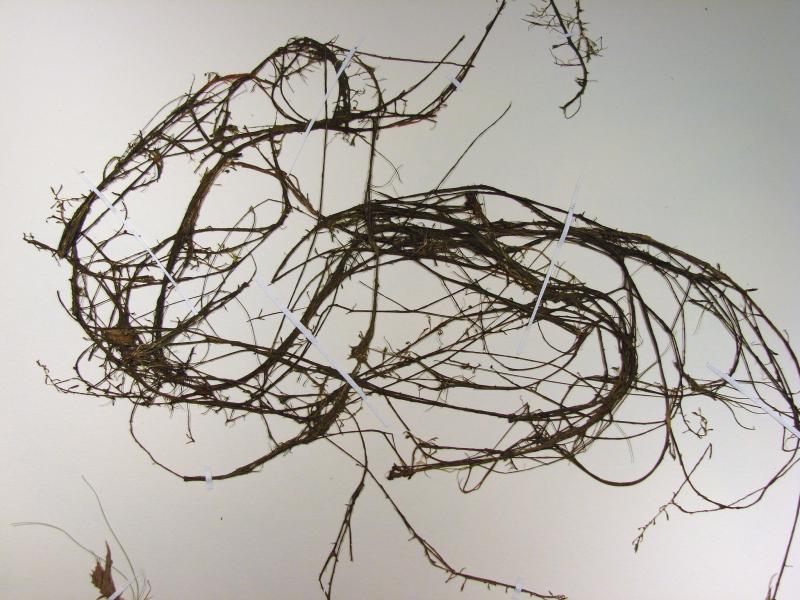Cut-leaved Water Milfoil
Myriophyllum pinnatum (Walt.) B.S.P.
- Class
- Dicotyledoneae (Dicots)
- Family
- Haloragaceae (Water-Milfoil Family)
- State Protection
- Endangered
Listed as Endangered by New York State: in imminent danger of extirpation in New York. For animals, taking, importation, transportation, or possession is prohibited, except under license or permit. For plants, removal or damage without the consent of the landowner is prohibited.
- Federal Protection
- Not Listed
- State Conservation Status Rank
- S1
Critically Imperiled in New York - Especially vulnerable to disappearing from New York due to extreme rarity or other factors; typically 5 or fewer populations or locations in New York, very few individuals, very restricted range, very few remaining acres (or miles of stream), and/or very steep declines.
- Global Conservation Status Rank
- G5
Secure globally - Common in the world; widespread and abundant (but may be rare in some parts of its range).
Summary
Did you know?
This is one of only two species of Myriophyllum in the state that has both alternate and whorled leaves. The other one is Myriophyllum farwellii, also rare. It's common name comes from the feathery appearance of its leaves and the genus name means numberless (Myrio) leaves (phyllum) referring to the many divided leaves (Fernald 1970).
State Ranking Justification
There are only four existing populations and one of these may have been extirpated from the incursion of seawater. There are seven historical populations from the first half of the 20th century in heavily developed areas and most of these are probably extirpated.
Short-term Trends
There has been a slight decline in existing populations as one site has probably been extirpated by the incursion of saltwater.
Long-term Trends
This species has always existed in low numbers in the state. Historical records from western Long Island have probably disappeared while new populations in the Hudson Highlands and eastern Long Island have been discovered.
Conservation and Management
Threats
Freshwater ponds close to the ocean may be affected by saltwater infiltration during storm events.
Conservation Strategies and Management Practices
Protect its pond and river habitat by preventing the alteration of water quality.
Habitat
Habitat
In New York this species has been discovered in and along the shores of small ponds and ditches as well as large lakes (Lake George) and the Hudson River. It apparently can tolerate sandy, rocky, or clayey substrates (New York Natural Heritage Program 2007). Peaty or muddy shores or in shallow waters (Fernald 1970).
Associated Ecological Communities
- Coastal plain pond*
(guide)
The aquatic community of the permanently flooded portion of a coastal plain pond with seasonally, and annually fluctuating water levels. These are shallow, groundwater-fed ponds that occur in kettle-holes or shallow depressions in the outwash plains south of the terminal moraines of Long Island, and New England. A series of coastal plain ponds are often hydrologically connected, either by groundwater, or sometimes by surface flow in a small coastal plain stream.
- Coastal plain pond shore*
(guide)
The gently sloping shore of a coastal plain pond with seasonally and annually fluctuating water levels. Plants growing on the pond shore vary with water levels. In dry years when water levels are low there is often a dense growth of annual sedges, grasses, and herbs. Submerged and floating-leaved aquatic plants, such as fragrant waterlily and pondweeds, may become "stranded" on the exposed shore. In wet years when the water level is high only a few emergents and floating-leaved aquatics may be noticeable. T
- Ditch/artificial intermittent stream
The aquatic community of an artificial waterway constructed for drainage or irrigation of adjacent lands. Water levels either fluctuate in response to variations in precipitation and groundwater levels, or water levels are artificially controlled.
- Inland non-calcareous lake shore*
The gravelly, sandy or muddy shore of an inland lake or pond with seasonally fluctuating water levels where the water is not calcareous. There may be few plants and those that are present are usually herbaceous.
- Oligotrophic pond
(guide)
The aquatic community of a small, shallow, nutrient-poor pond. The water is very clear, and the bottom is usually sandy or rocky.
- Riverside sand/gravel bar
(guide)
A meadow community that occurs on sand and gravel bars deposited within, or adjacent to, a river channel. The community may be very sparsely vegetated, depending on the rates of deposition and erosion of the sand or gravel.
- Shallow emergent marsh
(guide)
A marsh meadow community that occurs on soils that are permanently saturated and seasonally flooded. This marsh is better drained than a deep emergent marsh; water depths may range from 6 in to 3.3 ft (15 cm to 1 m) during flood stages, but the water level usually drops by mid to late summer and the soil is exposed during an average year.
* probable association but not confirmed.
Associated Species
- Bidens cernua (nodding beggar-ticks)
- Cyperus erythrorhizos (red-rooted flat sedge)
- Echinochloa crus-galli (Eurasian barnyard grass)
- Elatine minima (lesser waterwort)
- Eleocharis acicularis (needle spike-rush)
- Eleocharis elliptica (elliptic spike-rush)
- Hypericum mutilum
- Persicaria hydropiper (water-pepper)
- Rhynchospora capitellata (brownish beak sedge)
- Schoenoplectus purshianus
- Scirpus pu
Range
New York State Distribution
Most of our occurrences for Green Parrot's-feather are on Long Island, but it has also been found in Lake George (the Adirondacks), and in the Hudson River as far north as Washington County.
Global Distribution
Green Parrot's feather is found in most of the southern and central U.S. states, from Florida to New Mexico in the south. It reaches its northern limit in the Dakotas, Saskatchewan and British Columbia in the west, New York and Massachusetts in the east. It is a species of conservation concern throughout much of the northern part of its range.
Identification Comments
General Description
This is an aquatic, perennial plant of shallow water, sometimes also found growing along shorelines. The leaves develop in different form depending on whether they are above or below water. The submerged leaves are at least partly alternate, pinnate and featherlike, and 1-3 cm long. In the terrestrial form, and the above water (emersed) portion of aquatic plants, the leaves are in whorls. The flowers are not in separate spikes but arise individually along the stem just above each leaf, on emersed stems. The small, (2 mm) hard fruits are 4-parted and deeply lobed, with longitundinal ridges.
Similar Species
Myriophyllum farwellii, the only other species of Myriophyllum in New York with alternate leaves, has flowers borne in the axils of submersed leaves.
Best Time to See
The fruits mature in early July, and may persist on the stems into October.
- Flowering
- Fruiting
The time of year you would expect to find Cut-leaved Water Milfoil flowering and fruiting in New York.
Cut-leaved Water Milfoil Images
Taxonomy
Cut-leaved Water Milfoil
Myriophyllum pinnatum (Walt.) B.S.P.
- Kingdom Plantae
- Phylum Anthophyta
- Class Dicotyledoneae
(Dicots)
- Order Haloragales
- Family Haloragaceae (Water-Milfoil Family)
- Order Haloragales
- Class Dicotyledoneae
(Dicots)
- Phylum Anthophyta
Additional Common Names
- Green Parrot's Feather
- Milfoil
Synonyms
- Myriophyllum scabratum Michx.
- Potamogeton pinnatum Walter
Additional Resources
Best Identification Reference
Crow, Garrett E. and C. Barre Hellquist. 2000. Aquatic and Wetland Plants of Northeastern North America: A revised and enlarged edition of Norman C. Fassett's a Manual of Aquatic Plants. Volume One: Pteridophytes, Gymnosperms, and Angiosperms: Dicotyledons. The University of Wisconsin Press. Madison, Wisconsin. 536 Pages.
Other References
Aiken, S.G. 1981. A conspectus of Myriophyllum (Haloragaceae) in North America Brittonia 33(1):57-69.
Fernald, M.L. 1950. Gray's manual of botany. 8th edition. D. Van Nostrand, New York. 1632 pp.
Gleason, Henry A. and A. Cronquist. 1991. Manual of Vascular Plants of Northeastern United States and Adjacent Canada. The New York Botanical Garden, Bronx, New York. 910 pp.
Holmgren, Noel. 1998. The Illustrated Companion to Gleason and Cronquist's Manual. Illustrations of the Vascular Plants of Northeastern United States and Adjacent Canada. The New York Botanical Garden, Bronx, New York.
New York Natural Heritage Program. 2010. Biotics database. New York Natural Heritage Program. New York State Department of Environmental Conservation. Albany, NY.
New York Natural Heritage Program. 2024. New York Natural Heritage Program Databases. Albany, NY.
Ogden, E.C. 1974. Anatomical patterns of some aquatic vascular plants of New York. New York State Museum Bull. 424.
Taylor, Norman. 1915. Flora of the vicinity of New York. Memoirs of the New York Botanical Garden vol. V. New York, NY.
Weldy, T. and D. Werier. 2010. New York flora atlas. [S.M. Landry, K.N. Campbell, and L.D. Mabe (original application development), Florida Center for Community Design and Research http://www.fccdr.usf.edu/. University of South Florida http://www.usf.edu/]. New York Flora Association http://newyork.plantatlas.usf.edu/, Albany, New York
Weldy, Troy W. and David Werier. 2005. New York Flora Atlas. [S.M. Landry, K.N. Campbell, and L.D. Mabe (original application development), Florida Center for Community Design and Research. University of South Florida]. New York Flora Association, Albany, NY. Available on the web at (http://newyork.plantatlas.usf.edu/).
Links
About This Guide
Information for this guide was last updated on: December 11, 2008
Please cite this page as:
New York Natural Heritage Program. 2024.
Online Conservation Guide for
Myriophyllum pinnatum.
Available from: https://guides.nynhp.org/green-parrots-feather/.
Accessed July 26, 2024.
